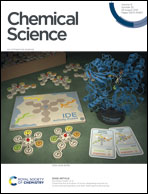Arsenic trioxide targets Hsp60, triggering degradation of p53 and survivin†
Abstract
The mechanisms of action of arsenic trioxide (ATO), a clinically used drug for the treatment of acute promyelocytic leukemia (APL), have been actively studied mainly through characterization of individual putative protein targets. There appear to be no studies at a system level. Herein, we integrate metalloproteomics through a newly developed organoarsenic probe, As-AC (C20H17AsN4O3S2) with quantitative proteomics, allowing 37 arsenic binding and 250 arsenic regulated proteins to be identified in NB4, a human APL cell line. Bioinformatics analysis reveals that ATO disrupts multiple physiological processes, in particular, chaperone-related protein folding and cellular response to stress. Furthermore, we discover heat shock protein 60 (Hsp60) as a vital target of ATO. Through biophysical and cell-based assays, we demonstrate that ATO binds to Hsp60, leading to abolishment of Hsp60 refolding capability. Significantly, the binding of ATO to Hsp60 disrupts the formation of Hsp60-p53 and Hsp60-survivin complexes, resulting in degradation of p53 and survivin. This study provides significant insights into the mechanism of action of ATO at a systemic perspective, and serves as guidance for the rational design of metal-based anticancer drugs.



 Please wait while we load your content...
Please wait while we load your content...